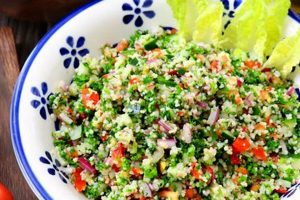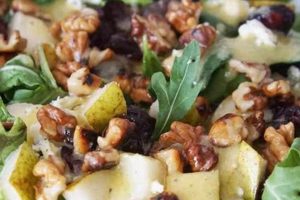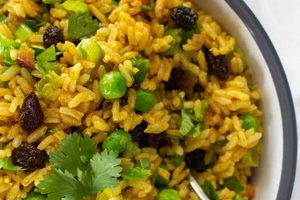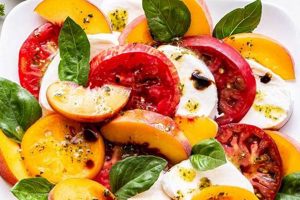Dishes featuring raw or lightly cooked turnips as a central ingredient offer a refreshing and nutritious alternative to traditional salads. These preparations often incorporate a variety of complementary ingredients, including other root vegetables, leafy greens, fruits, nuts, and cheeses, enhanced by vinaigrettes or creamy dressings. An example might include thinly sliced turnips tossed with baby spinach, toasted walnuts, crumbled goat cheese, and a lemon-herb vinaigrette.
Turnips, rich in vitamins, minerals, and fiber, contribute valuable nutrients to a balanced diet. Their peppery bite adds a unique flavor dimension, making them an interesting addition to salads. Historically, turnips have been a staple food source, particularly in colder climates, demonstrating their adaptability and culinary versatility. Their inclusion in salads elevates both the nutritional value and the gustatory experience.
This exploration will delve into various aspects of incorporating turnips into salads, covering topics such as selecting and preparing the root vegetable, creating complementary flavor combinations, and exploring different dressing options to maximize both taste and nutritional benefits.
Tips for Utilizing Turnips in Salads
Successfully incorporating turnips into salads requires an understanding of the vegetable’s properties and how to best complement its unique flavor profile. The following tips offer guidance for creating flavorful and appealing turnip-centric salads.
Tip 1: Select the Right Turnip: Smaller turnips tend to be sweeter and less pungent than larger, more mature ones. Look for firm, unblemished roots with vibrant greens attached (if available).
Tip 2: Proper Preparation is Key: Thoroughly wash and peel turnips before use. Slicing, dicing, or shaving the root into thin pieces creates a pleasant texture and allows the flavors to meld well with other ingredients.
Tip 3: Balance the Flavor Profile: The peppery bite of turnips pairs well with contrasting flavors. Consider incorporating sweet elements like apples or dried cranberries, creamy components like goat cheese or avocado, and crunchy additions such as nuts or seeds.
Tip 4: Choose Complementary Dressings: Vinaigrettes with bright acidity, such as lemon or apple cider vinegar, cut through the earthiness of turnips. Creamy dressings, particularly those with yogurt or buttermilk bases, also offer a pleasing contrast.
Tip 5: Don’t Overcrowd the Salad: Allow the turnips to shine by avoiding excessive ingredients. A few well-chosen components will create a more balanced and enjoyable salad.
Tip 6: Consider Marinating: Briefly marinating sliced turnips in a portion of the dressing can mellow their flavor and enhance their texture.
Tip 7: Utilize the Greens: Turnip greens are edible and highly nutritious. Incorporate them into the salad, either raw or lightly sauted, for added flavor and nutritional value.
By following these guidelines, one can create flavorful and nutritious salads that showcase the unique qualities of turnips while offering a delightful culinary experience.
These preparation and combination strategies provide a foundation for creating a diverse range of turnip salad recipes, catering to various palate preferences and dietary needs. Experimentation with flavors and textures is encouraged to discover individual favorites.
1. Turnip Variety
Turnip variety selection significantly influences the final flavor profile and textural experience of a salad. Choosing the appropriate turnip cultivar is paramount for achieving the desired culinary outcome. The following facets highlight the key considerations regarding turnip variety in the context of salad preparation.
- Sweetness and Pungency
Turnip varieties exhibit a spectrum of sweetness and pungency. Hakurei turnips, known for their mild, sweet flavor and delicate texture, are ideal for raw applications. Conversely, larger, more mature turnips possess a more pronounced peppery flavor, potentially requiring cooking or marinating to mellow their pungency before inclusion in salads.
- Texture and Density
Texture variations among turnip varieties impact their suitability for different salad preparations. Denser turnips hold their shape well when roasted or cubed, while more delicate varieties are better suited for shaving or thin slicing. Consider the desired texture when selecting a turnip variety.
- Color and Visual Appeal
The visual appeal of a salad is enhanced by incorporating diverse colors and textures. Turnips offer a range of colors, from white and purple to yellow and orange. Consider the overall color palette of the salad when selecting a turnip variety to create a visually appealing dish.
- Seasonality and Availability
Different turnip varieties thrive in different seasons. While some are available year-round, others are best enjoyed during specific times of the year. Incorporating seasonal turnips adds a touch of freshness and variety to salads.
Careful consideration of these facets related to turnip variety ensures a well-balanced and flavorful salad. Selecting the right turnip based on its inherent characteristics, combined with appropriate preparation methods, allows this versatile root vegetable to shine in a variety of salad creations.
2. Preparation Methods
Preparation methods significantly influence the flavor, texture, and overall appeal of salads featuring turnips. The manner in which turnips are handled before incorporation directly impacts their integration with other salad components. Different techniques yield varying results, affecting the vegetable’s inherent qualities and its contribution to the final dish. For instance, thinly shaving raw turnips creates a delicate, almost crisp texture, suitable for salads emphasizing freshness and lightness. This method preserves the turnip’s peppery bite, offering a contrasting element to sweeter or richer ingredients. Conversely, roasting diced turnips brings out their natural sweetness and yields a tender texture, complementing heartier salad compositions, particularly those featuring roasted or grilled elements.
Furthering the versatility of turnips in salads, pickling offers another dimension of flavor and texture. Pickled turnips provide a tangy, slightly acidic counterpoint to other ingredients, adding a layer of complexity to the overall salad profile. This method also extends the shelf life of prepared turnips, offering a convenient option for meal prepping. Another preparation involves quickly blanching sliced or diced turnips, reducing their pungency while maintaining a pleasant crunch. This technique bridges the gap between raw and fully cooked, offering a balance suitable for various salad styles. The choice of preparation method depends on the desired outcome and the overall composition of the salad, highlighting the importance of considering this element in recipe development.
Understanding the impact of various preparation methods on turnips allows for strategic manipulation of their inherent characteristics to achieve specific culinary goals. Whether seeking a crisp, peppery bite, a mellow sweetness, or a tangy accent, the chosen preparation method acts as a crucial tool in shaping the final salad experience. This knowledge empowers culinary creativity, enabling the development of diverse and flavorful turnip-based salads tailored to individual preferences and dietary needs.
3. Complementary Ingredients
The success of a salad featuring turnips hinges significantly on the thoughtful selection of complementary ingredients. These accompanying components interact with the turnip’s distinct flavor profile, either by providing contrast or enhancing its inherent qualities. Balancing textures and flavors is essential for creating a harmonious and enjoyable culinary experience.
- Fruits and Sweet Elements
The peppery notes of turnips are often balanced by incorporating sweet or acidic fruits. Apples, pears, grapes, and dried cranberries offer a contrasting sweetness that complements the turnip’s earthiness. Citrus segments, such as oranges or grapefruits, provide a bright acidity that cuts through the richness of certain dressings and enhances the turnip’s flavor.
- Cheeses and Creamy Components
Creamy cheeses, such as goat cheese, feta, or blue cheese, introduce a rich, savory element that complements the turnip’s texture and flavor. These cheeses offer varying levels of sharpness and saltiness, providing depth and complexity. Avocado, another creamy option, adds a healthy fat component and a smooth texture that contrasts with the crispness of the turnips.
- Nuts and Seeds
Nuts and seeds contribute textural complexity and enhance the nutritional value of turnip salads. Toasted walnuts, pecans, or almonds offer a satisfying crunch and nutty flavor that pairs well with both raw and cooked turnips. Seeds, such as sunflower or pumpkin seeds, provide a similar textural element and offer additional nutritional benefits.
- Leafy Greens and Herbs
Incorporating leafy greens adds volume and nutritional value. Baby spinach, arugula, or mesclun mix provide a bed of freshness that complements the turnip’s flavor and texture. Fresh herbs, such as parsley, dill, or mint, introduce aromatic complexity and elevate the overall flavor profile.
Strategic combination of these complementary ingredients transforms a simple turnip into a complex and flavorful salad. Careful consideration of flavor profiles, textures, and nutritional values allows for the creation of well-balanced and satisfying salads that showcase the versatility of this often-underappreciated root vegetable.
4. Dressing Selection
Dressing selection is paramount in maximizing the flavor potential of salad turnip recipes. The dressing acts as a unifying element, binding the various components and enhancing their individual characteristics. A well-chosen dressing complements the natural flavors of the turnips and other ingredients, creating a balanced and harmonious culinary experience. Conversely, an ill-suited dressing can overpower or clash with the delicate flavors, diminishing the overall enjoyment of the salad.
- Acidity and Brightness
Dressings with a pronounced acidity, such as those featuring lemon juice, vinegar, or citrus fruits, cut through the earthiness of turnips and provide a refreshing counterpoint. This brightness balances the sometimes-pungent flavor of raw turnips and enhances the overall flavor profile of the salad. A lemon-herb vinaigrette, for example, provides a vibrant acidity that complements the peppery notes of the turnip while adding a layer of herbaceous complexity.
- Creaminess and Richness
Creamy dressings, often based on yogurt, buttermilk, or tahini, offer a contrasting textural and flavor element. These dressings can mellow the sharpness of turnips, particularly when used with more mature or robust varieties. A creamy dill dressing, for instance, provides a smooth, cooling counterpoint to the crispness of the turnips, creating a balanced and satisfying combination.
- Sweetness and Balance
Incorporating a touch of sweetness into the dressing can further enhance the flavor profile of turnip salads. Honey, maple syrup, or fruit purees can be added to vinaigrettes or creamy dressings to provide a subtle sweetness that complements the earthiness of the turnips and balances the acidity or richness of other ingredients. A maple-Dijon vinaigrette, for example, adds a nuanced sweetness and a touch of tang that complements the peppery bite of the turnips.
- Oil Selection and Flavor Profile
The type of oil used in the dressing also plays a crucial role in the final flavor profile. Extra virgin olive oil provides a robust, fruity flavor, while lighter oils, such as grapeseed or avocado oil, offer a more neutral base that allows the other flavors to shine. The choice of oil should complement the overall flavor profile of the salad and the specific variety of turnip used.
The careful selection of a dressing, considering its acidity, creaminess, sweetness, and oil profile, is essential for creating a successful turnip salad. A well-chosen dressing elevates the inherent flavors of the turnips and other ingredients, resulting in a balanced and satisfying culinary experience. By understanding the interplay of these elements, one can create turnip salads that showcase the versatility and deliciousness of this often-overlooked root vegetable.
5. Flavor Balancing
Flavor balancing is crucial in crafting successful salad turnip recipes. The inherent pungency and earthiness of turnips necessitate careful consideration of contrasting and complementary flavors to create a harmonious and palatable dish. A well-balanced salad turnip recipe avoids overwhelming the palate with any single flavor, instead highlighting the turnip’s unique characteristics while integrating them seamlessly with other components.
- Acidity as a Counterpoint
The peppery bite of turnips often benefits from the inclusion of acidic elements. Vinegars, citrus juices, and acidic fruits like green apples or cranberries provide a refreshing contrast to the turnip’s earthiness. This interplay of flavors prevents the turnip from dominating the palate, creating a more balanced and enjoyable sensory experience. For example, a lemon vinaigrette or the addition of pomegranate seeds can effectively cut through the richness of a turnip and goat cheese salad.
- Sweetness and Complexity
Incorporating sweet elements can further enhance the flavor profile of turnip salads. A touch of honey or maple syrup in a vinaigrette, or the addition of dried fruits or roasted root vegetables, adds depth and complexity. This sweetness balances the peppery notes of the turnip, preventing the salad from becoming overly sharp or bitter. A salad featuring roasted turnips, caramelized onions, and candied walnuts exemplifies this principle.
- Textural Considerations
Flavor balancing extends beyond simply combining contrasting tastes. Texture plays a crucial role in the overall perception of flavor. The crispness of raw turnips can be balanced by incorporating creamy elements like avocado or goat cheese, or crunchy elements like toasted nuts or seeds. This interplay of textures adds another layer of complexity and prevents the salad from becoming monotonous. For example, a salad combining thinly sliced turnips with creamy feta, toasted almonds, and crisp lettuce offers a variety of textures that enhance the overall flavor experience.
- Herbaceous and Aromatic Notes
Fresh herbs and aromatics contribute significantly to flavor balancing in turnip salads. Dill, mint, parsley, and chives introduce bright, herbaceous notes that complement the earthiness of the turnip. These additions provide a refreshing lift and prevent the salad from tasting too heavy or one-dimensional. A salad featuring shaved turnips, crumbled feta, and a generous sprinkle of fresh dill exemplifies the impact of herbaceous notes.
These facets of flavor balancing underscore the importance of thoughtful ingredient selection and preparation in salad turnip recipes. Achieving a harmonious balance of flavors and textures ensures a more enjoyable and satisfying culinary experience, showcasing the versatility and deliciousness of this often-underappreciated root vegetable.
6. Presentation and Serving
Presentation and serving significantly impact the overall dining experience of salad turnip recipes. Visual appeal enhances enjoyment and perception of flavor, transforming a simple dish into a culinary delight. Consideration of serving techniques and plating aesthetics elevates the perceived value and enjoyment of these often-underappreciated root vegetables.
- Visual Appeal and Color Contrast
A visually appealing salad entices the appetite and enhances the dining experience. Turnips, while often pale in color, offer opportunities for creative presentation. Contrasting colors through the incorporation of vibrant greens, colorful fruits, or deeply hued cheeses and nuts creates visual interest. For example, a salad of white turnips can be brightened with the addition of ruby-red grapefruit segments, deep green spinach, and crumbled blue cheese. This contrast not only adds visual appeal but also highlights the diversity of flavors and textures.
- Texture and Height Variation
Varying textures and creating height on the plate adds visual dynamism. Thinly shaved turnips can be layered with more substantial components, such as roasted vegetables or crumbled cheese, creating a visually appealing textural contrast. Adding height to the salad, either through mounding or layering, draws the eye and makes the dish more enticing. A salad featuring a base of shredded turnips topped with a mound of roasted chickpeas, crumbled feta, and a sprinkle of fresh herbs exemplifies this principle.
- Serving Temperature and Freshness
Serving temperature significantly impacts the flavor and texture of turnip salads. Salads featuring raw turnips are best served chilled to enhance their crispness and refreshing qualities. Conversely, salads incorporating roasted or cooked turnips may be served warm or at room temperature to highlight their earthy sweetness. Attention to serving temperature ensures optimal enjoyment of the various components. Serving a salad with wilted greens or lukewarm roasted vegetables detracts from the overall experience.
- Portion Size and Garnishing
Appropriate portion sizes and thoughtful garnishing contribute to a positive dining experience. Overly large portions can be overwhelming, while overly small portions may leave diners unsatisfied. Careful portioning ensures that all flavors and textures can be appreciated without excess. Garnishing, while seemingly a minor detail, adds a final touch of elegance and visual appeal. A sprinkle of chopped fresh herbs, a drizzle of high-quality olive oil, or a scattering of toasted nuts or seeds elevates the presentation and completes the dish. A simple garnish of toasted sesame seeds on a salad of shaved turnips and shredded carrots enhances both visual appeal and flavor.
These considerations regarding presentation and serving enhance the enjoyment of salad turnip recipes. Visual appeal, textural variation, appropriate temperature, and thoughtful portioning elevate these dishes, transforming them from simple salads into culinary experiences. Attention to these details demonstrates care and consideration, ultimately contributing to a more satisfying and memorable dining experience.
Frequently Asked Questions
This section addresses common inquiries regarding the utilization of turnips in salads, providing clear and concise information to facilitate culinary exploration and address potential concerns.
Question 1: How can the strong flavor of turnips be mitigated in salads?
The perceived strong flavor, often described as peppery or pungent, can be mitigated through several methods. Selecting smaller, younger turnips generally offers a milder flavor profile. Briefly blanching or marinating sliced turnips in an acidic medium, such as lemon juice or vinegar, also mellows the flavor while maintaining a desirable texture.
Question 2: Are all turnip varieties suitable for raw consumption in salads?
While most turnip varieties can be consumed raw, certain cultivars, like the Hakurei turnip, are particularly well-suited for salads due to their inherent sweetness and delicate texture. Larger, more mature turnips may benefit from cooking or pickling before inclusion in salads to soften their texture and reduce pungency.
Question 3: What dressings complement the flavor of turnips in salads?
Vinaigrettes featuring bright acidity, such as lemon or apple cider vinegar, effectively cut through the earthiness of turnips. Creamy dressings, particularly those with yogurt or buttermilk bases, offer a pleasing contrast and can mellow the turnip’s flavor. The specific dressing choice depends on the other salad components and desired overall flavor profile.
Question 4: Can turnip greens be incorporated into salads?
Turnip greens are not only edible but also highly nutritious. They can be incorporated raw into salads, adding a slightly bitter, peppery flavor, or lightly sauted or steamed to mellow their flavor and soften their texture.
Question 5: How should turnips be stored to maintain freshness for salads?
Turnips should be stored in a cool, dark, and humid environment, ideally in a refrigerator. Storing them in a perforated plastic bag helps maintain optimal humidity. The greens should be removed before storage and can be stored separately in a similar manner.
Question 6: How long can prepared turnips be stored for use in salads?
Prepared turnips, whether raw, cooked, or pickled, can be stored in an airtight container in the refrigerator for up to three days. However, quality and flavor are best when consumed within one to two days of preparation.
Understanding these aspects of utilizing turnips in salads allows for successful integration of this versatile vegetable, maximizing its nutritional and culinary potential. Experimentation with different varieties, preparations, and complementary ingredients encourages culinary creativity and personalized flavor experiences.
This concludes the frequently asked questions section. The following section will provide a selection of specific salad turnip recipes showcasing diverse flavor combinations and culinary techniques.
Culinary Applications of Turnips in Salads
This exploration has examined the multifaceted nature of incorporating turnips into salads, encompassing varietal selection, preparation techniques, complementary ingredients, dressing choices, flavor balancing, presentation, and common inquiries. Emphasis has been placed on maximizing the culinary potential of this often-overlooked root vegetable, highlighting its nutritional value and unique flavor profile. The versatility of turnips, adaptable to both raw and cooked applications, allows for diverse culinary creations catering to a wide range of palate preferences. Careful consideration of these elements ensures successful integration of turnips into salads, transforming simple dishes into flavorful and visually appealing culinary experiences.
The resurgence of interest in root vegetables underscores the importance of understanding their culinary applications. Further exploration and experimentation with turnips in salads promise continued innovation and appreciation for their unique contributions to gastronomy. Cultivating an understanding of these culinary principles empowers both home cooks and professional chefs to unlock the full potential of turnips, transforming them from humble root vegetables into stars of the salad bowl.






